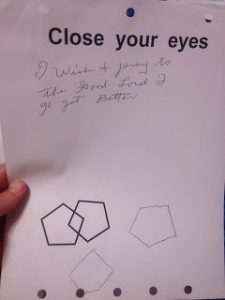Mat Man: Teach a Child How to Draw a Person Using Handwriting Without Tears
I had a first grader come in and I asked him to draw me a person. He did. It was the one on the left with the orange strip (which hides his name). So then I pulled out “Mat Man” with some slight modifications to his face since I was missing some pieces, lol. We went through “Mat Man”, which was developed by Handwriting Without Tears, and we talked about his body, his arms and legs, his ears, etc etc etc…then I drew Mat Man while he watched and I explained. Finally, he drew Mat Man, see drawing on right. This lesson was probably 10 minutes long. Pretty impressive, huh? To go from that left drawing to right drawing in a 10 minute span? We’ll need to do some follow-up to try to gain consistency.
*For those of you who are going to ask about the secret of Mat Man…there isn’t much of one. I showed him up above. He has a big blue body, stick arms and legs, curves for his head, etc…well you see him. Nothing is missing besides the hair (we ended using pencils for hair). I had to improvise his eyes and nose and smile etc, and in fact don’t remember what they normally use for that. It’s basically just the idea of showing them via 3-D objects and Handwriting Without Tears materials what a person looks like, before taking it to paper.
They also have songs about Mat Man. For kids who are auditory learners, they are pretty catchy 🙂
The Hidden Poignancy of the MMSE – When clients write a sentence.
The MMSE or Mini Mental State Exam is a 30-question exam that asks very basic questions and is designed to screen for cognitive impairment. I did a lot of them while I was doing a 3 month fieldwork as a Level II OT Student in a geriatric psychiatric ward in Tennessee back in 2009.
What I recall most about this exam is the poignancy of the responses when I would ask some of these clients to write me a sentence, any sentence they wanted. I wish now I had saved more of them. Some wrote things like “You are so pretty.”
Or “When will I get better?”
or “I want to leave.”
or simply writing down what I had said: “Write a sentence.”
One euphoric lady’s sentence was: “I am a very happy person and I love everyone.”
For one lady who talked/processed sooooo slowly, she reminded me of Alice in Wonderland, using circular answers such as: “That is the answer to which the answer is asked.” She could not remember the state she was in at all, or county, or town. She scored in moderate dementia range. Her written sentence was: “Please understand.” It gave me chills.
This particular lady (image) wrote “I wish and pray to the Good Lord I go get better” I seem to recall quite a few writing to the Lord to get better. It was always the sentence they wrote that was the most revealing to me as to their inner thoughts. Sometimes it made me smile, sometimes want to cry.
http://en.wikipedia.org/wiki/Mini%E2%80%93mental_state_examination
A feline SOAP Note
S: Nikki voiced her complaints of of arthritic pain in her joints
as well as stated she always has a generalized sense of anxiety.
Reports hobbies of watching ants, biting butts, sitting in windows,
and meowing.
O: Nikki was observed taking Amytriptline to calm herself. She
raced from room to room, meowing, as her owner cleaned. She jumped gingerly during window-ground transfers, and appeared agitated.
She bit the wrist of the owner’s friend and did not express remorse.
A: Nikki appears to have difficulty initiating appropriate social
interactions with other felines and humans. Sensory integration
approaches, such as a brush protocol and heating pad may help her
both with her anxiety and arthritic pain. ABA therapy could be used
to teach her to stop biting. She would also benefit from consistent
monitoring of her medications.
P: Discuss plan of care with owner & veterinarian. Visit home
again within one week to determine other possible negative environmental
influences. Train owner in proper sensory integration techniques, including Wilbarger brush protocol.
STG: Reduce Nikki’s biting by 50% using SI techniques, within two weeks.





